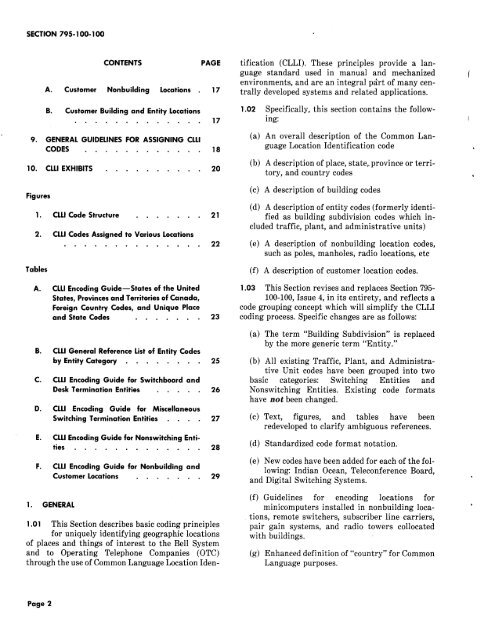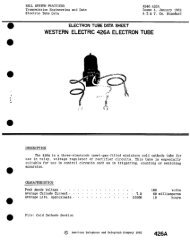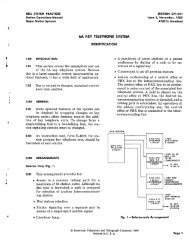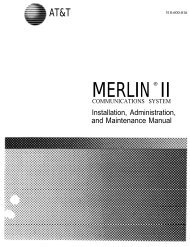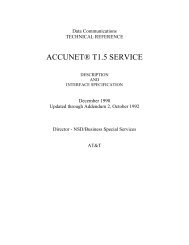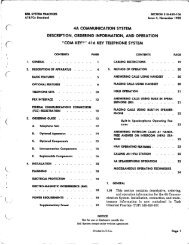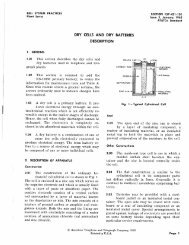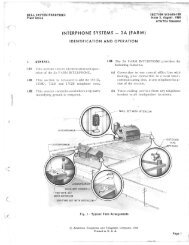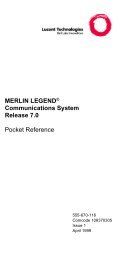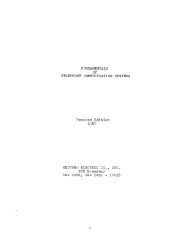COMMON LANGUAGE LOCATION IDENTIFICATION (CLLI) CODE ...
COMMON LANGUAGE LOCATION IDENTIFICATION (CLLI) CODE ...
COMMON LANGUAGE LOCATION IDENTIFICATION (CLLI) CODE ...
You also want an ePaper? Increase the reach of your titles
YUMPU automatically turns print PDFs into web optimized ePapers that Google loves.
SECTION 795-100-100<br />
CONTENTS PAGE<br />
A. Customer Nonbuilding locations . 17<br />
B. Customer Building and Entity locations<br />
9. GENERAL GUIDELINES FOR ASSIGNING Clll<br />
<strong>CODE</strong>S 18<br />
1 0. Clll EXHIBITS 20<br />
Figures<br />
1 . Clll Code Structure<br />
2. Clll Codes Assigned to Various locations<br />
Tables<br />
A. <strong>CLLI</strong> Encoding Guide-States of the United<br />
States, Provinces and Territories of Canada,<br />
Foreign Country Codes, and Unique Place<br />
and State Codes . . . . . . 23<br />
B.<br />
c.<br />
D.<br />
E.<br />
F.<br />
1. GENERAL<br />
Clll General Reference List of Entity Codes<br />
by Entity Category . . . . . . . .<br />
Clll Encoding Guide for Switchboard and<br />
Desk Termination Entities . . . . .<br />
Clll Encoding Guide for Miscellaneous<br />
Switching Termination Entities . . . .<br />
Clll Encoding Guide for Nonswitching Entities<br />
Clll Encoding Guide for Nonbuilding and<br />
Customer locations<br />
1.01 This Section describes basic coding principles<br />
for uniquely identifying geographic locations<br />
of places and things of interest to the Bell System<br />
and to Operating Telephone Companies (OTC)<br />
through the use of Common Language Location Iden-<br />
Page 2<br />
17<br />
21<br />
22<br />
25<br />
26<br />
27<br />
28<br />
29<br />
tification (<strong>CLLI</strong>). These principles provide a language<br />
standard used in manual and mechanized<br />
environments, and are an integral part of many centrally<br />
developed systems and related applications.<br />
1.02 Specifically, this section contains the following:<br />
(a) An overall description of the Common Language<br />
Location Identification code<br />
(b) A description of place, state,. province or territory,<br />
and country codes<br />
(c) A description of building codes<br />
(d) A description of entity codes (formerly identified<br />
as building subdivision codes which included<br />
traffic, plant, and administrative units)<br />
(e) A description of nonbuilding location codes,<br />
such as poles, manholes, radio locations, etc<br />
(f) A description of customer location codes.<br />
1.03 This Section revises and replaces Section 795-<br />
100-100, Issue 4, in its entirety, and reflects a<br />
code grouping concept which will simplify the <strong>CLLI</strong><br />
coding process. Specific changes are as follows:<br />
(a) The term "Building Subdivision" is replaced<br />
by the more generic term "Entity."<br />
(b) All existing Traffic, Plant, and Administrative<br />
Unit codes have been grouped into two<br />
basic categories: Switching Entities and<br />
Nonswitching Entities. Existing code formats<br />
have not been changed.<br />
(c) Text, figures, and tables have been<br />
redeveloped to clarify ambiguous references.<br />
(d) Standardized code format notation.<br />
(e) New codes have been added for each of the following:<br />
Indian Ocean, Teleconference Board,<br />
and Digital Switching Systems.<br />
(f) Guidelines for encoding locations for<br />
minicomputers installed in nonbuilding locations,<br />
remote switchers, subscriber line carriers,<br />
pair gain systems, and radio towers collocated<br />
with buildings.<br />
(g) Enhanced definition of "country" for Common<br />
Language purposes.


